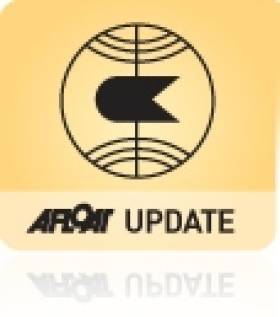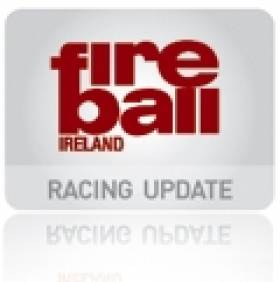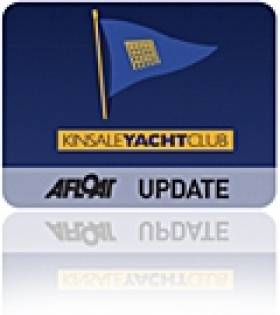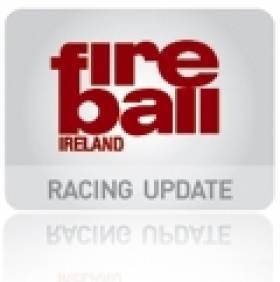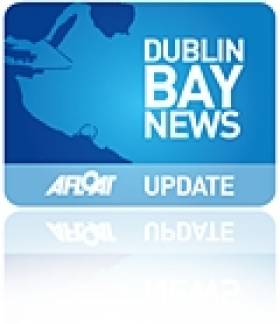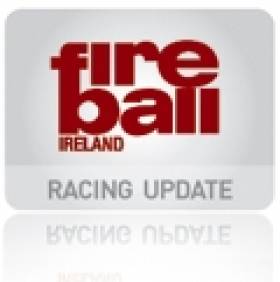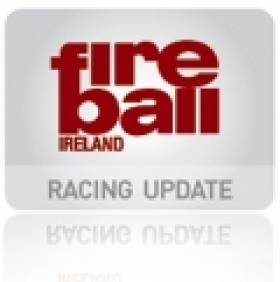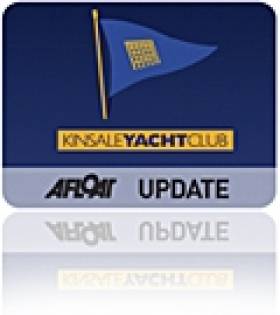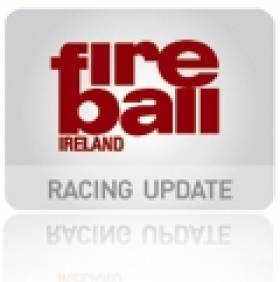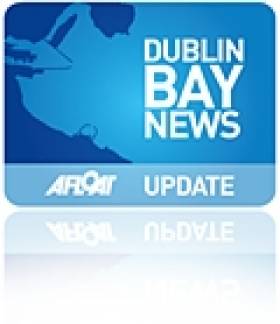Displaying items by tag: Frostbite
OK Dinghy Beats IDRA 14s for PY Frostbite Honours at DMYC
#dmycfrostbite – Winter ought to be over by now and the DMYC Frostbite series has come to the end of its 42nd year. Quite an institution. However, winter doesn't seem to be finished with us quite yet so 25-35 knot winds and temperatures of 2 degC confronted the fleets instead of the hoped-for Spring warmth.
The organisers and sailors left the decisions as long as possible in the hopes of one last race. There was no let up in the conditions and racing was cancelled for the day so the OK Dinghy didn't have to protect its lead in series 2. In any case, conditions at the RSGYC's slipway meant there was no way that the OK Dinghy could be launched. Enough of the easterly swell was reaching the slip to render any attempt at a launch both foolish and potentially dangerous....on that slipway at least.
However, the fleets took advantage of the lousy weather by heading for the DMYC where pints, prizes and Irish Tapas were the order of the day – along with some interesting announcements about the summer sailing.
In the PY fleet there were two sets of results up for grabs; the post-Xmas races in Series 2 and the Overall 2012/13 series.
The results in Series 2 were as follows:
OK Dinghy / Sheehy
GP14 / O'Brien & Sheridan
IDRA14 / Long & Rea
While the overall 2012/13 DMYC Frostbite series results were;
OK Dinghy / Sheehy
IDRA14 / Long & Rea
IDRA14 / Hamilton & Byrne
There was also a quick introductory talk about the activities of the Dún Laoghaire Dinghies team and the soon to be launched "Island Trial". These will be exciting additions to dinghy sailing on Dublin Bay in 2013
#fireball – The decision to race the Frostbites on St. Patrick's Day, 17th March, neither attracted a big fleet nor nice weather. The smallest Fireball fleet of the entire series, 9 boats, was greeted by damp grey, flat conditions and no obvious sign of the means to have a race. Getting out of the harbour was an extended exercise in kinetics and some of those who mistimed their departure from shore in the conditions will have been grateful for the postponement enforced on the Race Officer who had nothing to work with at the scheduled start of 14:00.
What little wind that did appear came out of the NE but it was very fickle and at its strongest on the first lap of the initial three lap course. Eight of the nine boats in the fleet worked the middle and left of the course. The exception was Conor Clancy, crewed by James Devlin (150**) who went right off the line. Neil Colin & Margaret Casey (14775) also went right but at a later stage of the first beat. The leaders in the series Noel Butler & Stephen Oram (15061) worked the middle to keep a watching brief on Kenny Rumball who had a guest crew in the form of Shane McCarthy (15058).
Clancy's right side play was rewarded when he rounded first but the second boat was Alistair Court and Gordon Syme (14706) who approached the weather mark on the port layline. Third round were Butler & Oram, followed by Colin & Casey and Rumball/McCarthy. However, at this stage the fleet was in close company and only a few boat lengths separated each of the boats from the one in front of them. The two reaches of the first triangle didn't conjure up any place changes.
On the second beat it was a case of not getting too far removed form your nearest opposition and as a consequence everyone ended up working the middle of the course to varying degrees. At this stage the wind was still reasonable in the context of the day. At the 2nd weather mark the leaders, Clancy/Devlin, Butler/Oram and Court/Syme gybed immediately to head inshore whereas Colin/Casey, Rumball/McCarthy and Louise McKenna and Hermine O'Keeffe (14691) stayed offshore. The second gybe mark was now a tidal challenge as the ebbing tide held the upper hand on the fading wind. It claimed one victim who then retired altogether.
As the leaders approached the leeward mark a shortened course was signalled. Clancy/Devlin and Butler/Oram were having a close quarter battle for the lead and they took slightly different approaches to the finish. Clancy/Devlin took a short hitch before tacking to the finish whereas Butler/Oram did the opposite. This promoted a very tight finish with the winning margin very much less than a boat-length.
|
42nd Frostbite Series by DMYC: Sunday 17th March 2013 |
|||
|
1 |
Conor Clancy & James Devlin |
150** |
RStGYC |
|
2 |
Noel Butler & Stephen Oram |
15061 |
DMYC |
|
3 |
Neil Colin & Margaret Casey |
14775 |
DMYC |
The Series 2 points table sees Butler & Oram with a healthy margin over Rumball & Kinsella/Moran who need to be aware of Team Clancy over their shoulders. A quick perusal of the score sheet for Butler & Oram confirms that their worst result in this Series is a 2nd.
|
42nd Frostbite Series, hosted by DMYC: Series 2 Overall. |
||||
|
1 |
Noel Butler & Stephen Oram |
15061 |
DMYC |
9pts |
|
2 |
Kenny Rumball & Conor Kinsella/Dave Moran |
15058 |
INSC |
17pts |
|
3 |
Conor & James Clancy |
150** |
RStGYC |
19pts |
|
4 |
Neil Colin & Margaret Casey |
14775 |
DMYC |
29pts |
|
5 |
Louise McKenna & Hermine O’Keeffe |
14691 |
RStGYC |
36pts |
|
6 |
Gavin Doyle & Dave Sweeney |
14953 |
NYC |
54pts |
The combined Series 1 and Series 2 table was also available yesterday and this promotes the prospect of a last race duel for the outright win as only two points separate 1st and 2nd. Rumball/Kinsella/Moran lead by 2pts from Butler/Oram and neither of them has to worry about the third placed combination, Team Clancy who are 13pts further back. Of course what actually happens on the water is a different story and putting boats between themselves and Rumball will be the prime objective of Butler & Oram. Let’s hope there is wind to make the finale a good one!
|
42nd Frostbite Series hosted by DMYC: Series 1 & 2 Combined. |
||||
|
1 |
Kenny Rumball & Conor Kinsella/Dave Moran |
15058 |
INSC |
17pts |
|
2 |
Noel Butler & Stephen Oram |
15061 |
DMYC |
19pts |
|
3 |
Conor & James Clancy |
150** |
RStGYC |
32pts |
|
4 |
Neil Colin & Margaret Casey |
14775 |
DMYC |
56pts |
|
5 |
Louise McKenna & Hermine O’Keeffe |
14691 |
RStGYC |
75pts |
Laser Sharp Kenneally Wins Kinsale Yacht Club Frostbite Sailing Prize
#kinsale – Ronan Kenneally received the Laser Standard Trophy, Darragh O'Sullivan – the inaugural ASM Radial Trophy, Richard Thompson – the 4.7 Destiny Trophy and Colm Dunne – the Squib Trophy after the final race day of the ASM-Marine KYC Frostbite League.
The early calm conditions on the final day of the ASM-Marine Frostbite League at Kinsale Yacht Club last Sunday morning did not look promising. With two previous race days cancelled due to an excess of wind it was more in hope than expectation that the Race Committee lead by OD Bruce Mathews decided to take to the race area. Their positive action was soon rewarded as the predicted South-Easterly Force 2 to 3 arrived ensuring a timely start to the final day's programme.
With a top mark laid in close proximity to Kinsale boatyard, and the incoming tide early in its cycle, a windward-leeward course was offered to the four competing classes. As racing progressed, with the South-Easterly variable and backing at times thirty to forty degrees and the flood tide increasingly more affective, the usual critical decision of which side of the beat to favour was complicated by the opposing set of conditions.
Consistency was the foundation once again this year for Ronan Kenneally (MBSC) as the returning Champion retained the Laser Standard title. Never out of the top two in any race and scoring seven wins in total, Ronan's final flourish of a second and two firsts placed him in an unassailable lead at the top of this class. Finishing in second and third overall were Matthias Hellstern (KYC) and James Long (Inniscarra SC) with two seconds and a third and two thirds and a second respectively.
Already clear ahead at the top of the Radial Fleet, an off-form Darragh O'Sullivan still retained his overall title from last year, despite just two fifth places on Sunday. Successful on the day were Ewan O'Keeffe (CSC) who won the first race with Dermot Lyden (BSC/RCYC) and Aisling Keller (LDYC/KYC) sharing the next two races, each scoring a win and a second.
Having led the Laser 4.7 League throughout, Richard Thompson (RCYC/KYC) with a fifth and a third still managed to repel a late challenge from Cliodhna O'Regan (KYC) who took line honours in the last two races of the day. Unable to discard a 'maximum points' scoring, Cliodhna had to settle for second overall. Florence Lyden (BSC) had her best day to date with two seconds.
The conclusion to the 2013 Squib Class League had all the promise of a closely fought contest for the top spot, between two very well matched boats. Neither of the two crews directly involved, nor the few privileged to view the contest could have envisaged the enfolding drama. Colm Dunne and Rob Gill in Allegro (KYC), started the first race holding an advantage overall of just a single point, to Marcus & Meagan Hutchinson in Sensation (KYC). Allegro lost that one point advantage in the first race, only to regain it emphatically in the second, thus ensuring the outcome of the final race would determine the winner. With the overall points scoring always subject to the two discards rule, both crews must have been frantically doing the 'Math' at that stage. Concerned only with the relative position of their immediate opponents and with both crews sailing tactically, Allegro quickly established a winning lead only to surrender this at a top-mark 'port and starboard' incident. Accepting the required penalty, they still managed to collect a fourth place to Sensation's second. However, with Allegro's fourth in this race and Sensation's fifth in the second going to discard, Colm Dunne & Rob Gill emerged as worthy Champions by virtue of that single point. On this occasion, Marcus & Meagan Hutchinson had to settle for second place, while Paul McCarthy & Paul Cotter held onto third place also with an excellent first and a second.
Prize-Giving was hosted by Commodore Cameron Good, who on behalf of Kinsale Yacht Club congratulated the deserving winners and thanked all the sailors for their efforts. Special mention went to PRO Bruce Mathews for his continuing and enthusiastic support for this event. Appreciation was additionally expressed for the support of the various Committee members, the Sponsor and the many helpers who had assisted, both on and off the water, to make this annual and long-standing event such an enjoyable regatta. The Commodore awarded the prizes for each class which were presented by Agnes McLaverty on behalf of ASM-Marine. Ronan Kenneally received the Laser Standard Trophy, Darragh O'Sullivan – the inaugural ASM Radial Trophy, Richard Thompson – the 4.7 Destiny Trophy and Colm Dunne – the Squib Trophy.
Safety First as Climate & Ferry Interrupt Dinghy Harbour Frostbite Series
#frostbites – Saturday afternoon's wintry showers, which significantly reduced visibility in Dun Laoghaire harbour, gave way to sunshine and blue skies on Sunday morning writes Cormac Bradley. Unfortunately, from a racing perspective, the disappeared snow took the wind with it and we were left with a patchwork quilt of calm areas and small pockets of breeze blowing from every which way within the confines of the harbour.
The lack of motive power for the racing fleets meant that another element of harbour traffic had to be considered in the Race Officer's thoughts on the viability of racing.
Due to the maintenance regime for the ferries that sail out of Dublin and the consequences of damage to one of the berthing facilities in Holyhead, the HSS crossing of the Irish Sea is back operating in Dun Laoghaire. With a scheduled departure that would have coincided with the middle of the racing "window", the absence of wind meant that dinghies could potentially compromise the manoeuvres of the HSS in getting out of the harbour. As the ferries hold the right of way, that was an unacceptable prospect, so racing was abandoned.
So despite glorious sunshine and modest air temperatures, racing was replaced with watching rugby. Don't need to detail the reaction to that exercise!
Ryan Team Out in Front at Dun Laoghaire Frostbite
#FROSTBITE – Frank Hamilton and Jennifer Byrne had a great turn of speed in their IDRA 14 dinghy getting on all the tricky harbour shifts and even beating the two RS200s to the finish line last Sunday at the DMYC Frsotbite series. Two Mirror teams had a battle all the way around until a leeward mark tangle with the Laser fleet put some distance between them.
Once more the most impressive sailing was out front with the Emmett and James Ryan and team showed their heels in the RS400, winning again with some excellent sailing. Results are below to download.
The Fireball race report by Cormac Bradley is here.
Fireballers Butler and Oram Stretch their Lead
#FIREBALL – Fifteen Fireballs took to the water for last Sunday's Frostbite race but only 14 of them got a finish – Andy Boyle & Barry Hurley (14934, Royal Irish) – were recorded as an OCS! Wind conditions were lively with a WSW Force 4/5 blowing with gusts flashing across the course. The start had a boat-end bias for a change and my various correspondents advise that there were a few capsizes on the day. It also appears that people were doing 720º and 360º for rule infringements and mark-touching.
The first three boats over the finish line, Noel Butler & Stephen Oram, Neil Spain & Hugh Butler and Owen Laverty & Ed Butler effectively sailed their own separate race from the rest of the fleet and they enjoyed a race of nip and tuck with places changing between them.
Neil Colin & Margaret Casey finished fourth but behind them a tight bunch were fighting for places. Included in this group were Messrs Rumball & Moran, Malcolm & Diviney, Court & Syme and Miller/Donnelly before the all-lady teams of McKenna & O'Keefe and Power & Barry.
The ladies were well represented today with three all-female teams out on the water, the third being Mary Chambers and Brenda McGuire, who finished thirteenth. Derval O'Carroll was also a welcome returnee to the Frostbites, sailing with Stephen Campion. And our Sligo friends, Peter Armstrong & Matt mayron were also out sailing the all-wooden 15060.
Class stalwart Louis Smyth, sailing with Joe O'Reilly, had a bad day at the office – an early interaction with another boat required a 720º with a capsize thrown in as a "double-whammy". At the first weather mark there was another revolution taken when they hit the mark. "Enough said!"
|
DMYC Frostbites; Race 4, Series 2, February 5th. |
|||
|
1 |
Noel Butler & Stephen Oram |
15061 |
DMYC |
|
2 |
Neil Spain & Hugh Butler |
14807 |
RStGYC |
|
3 |
Owen Laverty & Ed Butler |
14990 |
RStGYC |
|
4 |
Neil Colin & Margaret Casey |
14775 |
DMYC |
|
5 |
Kenneth Rumball & David Moran |
15058 |
INSC |
Mug winners for the day were the ladies of 14691, Louise McKenna & Hermine O'Keefe of the Royal St. George Yacht Club.
In overall terms, Butler & Oram stretched their lead over Rumball/Moran to 5pts, while the latter pair have a comfortable 8pt margin over third placed Laverty/Butler.
|
DMYC Frostbites; Series 2: Overall |
|||
|
1 |
Noel Butler & Stephen Oram |
DMYC |
5 |
|
2 |
Kenneth Rumball & David Moran |
INSC |
10 |
|
3 |
Owen Laverty & Ed Butler |
RStGYC |
18 |
|
4 |
Louise McKenna & Hermine O’Keefe |
RStGYC |
32 |
|
5 |
Neil Colin & Margaret Casey |
DMYC |
35 |
Fireballs Get a Soggy Frostbite Restart
After last week’s racing was abandoned due to high winds, a soggy Dun Laoghaire saw the restart of the Frostbite racing yesterday. It rained the entire day and initially there didn’t seem to be enough breeze to warrant a race, despite a forecast that suggested there would be lots of wind.
Twelve Fireball started the race, with one boat recording a DNF, and the wind filled in sufficiently to give a steady breeze though there was very little trapezing and downwind sailing was quite benign!
Messrs Butler/Oram and Rumball/Moran did their usual thing of leading the fleet off the start line with both boats fancying the LHS of the course. Those who went right found themselves off the pace though subsequent beats saw a wider corridor of favourable wind to work one’s way upwind. Neil Colin & Margaret Casey and John Chambers & Hugh Butler were two combinations who didn’t have the best of starts but worked their way left-wards and came into the first weather mark along the port lay-line in “very good nick” to secure places behind the front two. Behind these four there was a chasing group who kept close company with each other – Louise McKenna & Conor Kinsella, Andy Boyle & Conor Clancy, Frank Miller & Grattan Donnelly, Gavin Doyle & Richard Franck, Owen Laverty & Ed Butler and the all ladies team of Cariosa Power & Marie Barry.
This was the running order until the end of the second beat, when the Power & Barry combination dropped a place to Louis Smyth & Cormac Bradley. The latter combination had a poor first beat, even though they had gone left and spent the balance of the race playing “catch-up”.
Doyle/Franck & McKenna/Kinsella were the competing combinations for the day’s mugs, all those ahead of them having won one already and they were in close company for most of the race. Doyle/Frank got ahead during round three and held onto this “mug-winning” slot to the end of the race, shortened to 4 laps. At the front of the fleet it was a bit processional with Butler/Oram winning again from Rumball/Moran. After pulling the iron out of the fire at the end of the first beat, Colin/Casey finished third, while Doyle/Franck climbed to a lofty 4th and were followed home by Boyle/Clancy.
|
DMYC Frostbites; Series 2, Race 3 |
||
|
1 |
Noel Butler & Stephen Oram |
15061 |
|
2 |
Kenny Rumball & David Moran |
15058 |
|
3 |
Neil Colin & Margaret Casey |
14755 |
|
4 |
Gavin Doyle & Richard Franck |
14765 |
|
5 |
Andy Boyle & Conor Clancy |
14934 |
In terms of the overall situation in Series 2, the leading two are separated by a point and have a comfortable advantage over the next placed boat.
|
DMYC Frostbites, Series 2; Overall. |
|||
|
1 |
Noel Butler & Stephen Oram |
15061 |
4pts |
|
2 |
Kenny Rumball & David Moran |
15058 |
5pts |
|
3 |
Owen Laverty & Ed Butler |
14990 |
15pts |
|
4 |
Louise McKenna & Hermine O’Keefe |
14691 |
23pts |
|
5 |
Cariosa Power & Marie Barry |
14854 |
26pts |
Kinsale's Frostbite Series in Full Swing (Photos here!)
#KINSALE–Sailing in the annual ASM Marine sponsored Kinsale Yacht Club Frostbite series is underway inside Kinsale Harbour. Brian Carlin captured yestrerday's action (below) in the Squib keelboat and dinghy classes.
The league runs over six Sundays in Late Jaunary and February about sixty sailors will enjoy short sharp races on the Bandon River in underneath Kinsale's famous Charles Fort.
Racing features starts for all singlehanded Laser classes, mixed dinghies and Squibs. Three races are scheduled for each class every weekend. If the full programme is sailed over the six weeks that will see 18 starts for each class.
Entry fees are modest and include mooring and dinghy park space for all competitors.
Crash Gybes Plus a Win for the Ladies!
#FROSTBITE – The second Dun Laoghaire frostbite race of 2012 was sailed in blustery, breezy and shifty conditions in Dun Laoghaire’s harbour on Sunday 15th January. A very healthy turnout of 17 boats contested a 5 lap race which saw the on the water results transformed by multiple OSC entries on the score sheet posted in DMYC’s clubhouse.
Four transgressors of the starting procedure were caught, including the day’s winners on the water Messrs Neil Spain and Hugh Butler. This left the legal winners on the water as Kenny Rumball and Conor Kinsella, followed home, a boat length later, by Noel Butler and Stephen Oram.
Alaistair Court & Gordon Syme took third and after two races in this half of the series, these three fill the top three places overall with Rumball/Moran & Butler/Oram tied in 1st place.
Two all-lady combinations sailed the day with Cariosa Power & Marie Barry (Class Treasurer) finishing 6th two spots ahead of Louise McKenna & Hermine O’Keefe. This performance was enough to give Power & barry the day’s mugs which is all the more commendable as they saild a conservative race by keeping the spinnaker in the bag.
Crash gybes, to avoid collisions, caused Frank Cassidy & John Hudson and Owen Laverty & Ed Butler to take a swim on the day, but the latter combination recovered to finish 5th. Noel Butler also reports that the may have been a “T-boning” incident between a Fireball and a RS400 and Luke Malcolm ended up as the walking wounded with a bad gash on his knee after a toe-strap broke, causing him to be thrown into the gunwhale.
All told, an adventurous day on the water in what were somewhat colder conditions that we have had thus far.
|
DMYC Frostbites 2011/12 |
||||
|
|
Series 2, Race 2 |
|
|
Overall |
|
1 |
Kenneth Rumball & David Moran |
15058 |
INSC |
= 1 |
|
2 |
Noel Butler & Stephen Oram |
15061 |
DMYC |
= 1 |
|
3 |
Alaistair Court & Gordon Syme |
14706 |
DMYC |
3rd |
|
4 |
Neil Colin & Margaret Casey |
14775 |
DMYC |
11th |
|
5 |
Owen Laverty & Ed Butler |
14990 |
RStGYC |
4th |
(Race notes with the assistance of Noel Butler).
Butler and Oram Lead Dun Laoghaire Fireball Frostbites
The second half of DMYC’s Frostbite series was initiated on Sunday, 8th January, when amongst others, 12 Fireballs, contested the first race of Series 2. While they may not have had things entirely their own way on the water at the start, there is a familiarity to the final race results with Messrs Butler & Oram in 1st place and Messrs Rumball & Moran in 2nd.
This scribe was not part of the proceedings but my information is that pre-launch, the wind was getting up to 30knots which put the prospect of racing in severe jeopardy. However, the wind abated and in mildish conditions (10º for January), six rounds were sailed inside Dun Laoghaire’s harbour. With a mean wind direction of 270º, right was the way to go, but I am told that Butler/Oram went left which left them playing catch-up. Rumball/Moran thus played the part of pathfinder ! The wind moderated to about Force 4 for the duration of the race.
The first race of 2012 saw Owen Laverty and Ed Butler make their first appearance in the Frostbites and they were rewarded with 3rd place on the finish which also resulted in them winning the day’s mugs.
|
DMYC Frostbites, Series 2 : 8th January 2012 |
||
|
1 |
Noel Butler & Stephen Oram |
DMYC - 15061 |
|
2 |
Kenneth Rumball & David Moran |
INSC - 15058 |
|
3 |
Owen laverty & Ed Butler |
RStGYC - 14990 |
|
4 |
Alaistair Court & Gordon Syme |
DMYC - 14706 |
|
5 |
Louis Smyth & Joe O’Reilly |
RCH - 15007 |


























